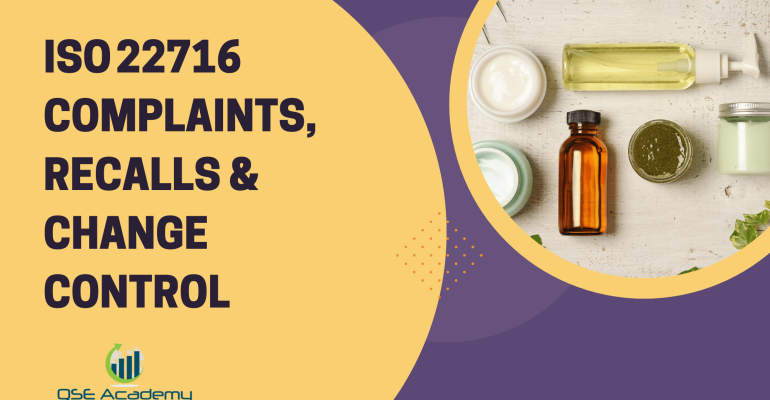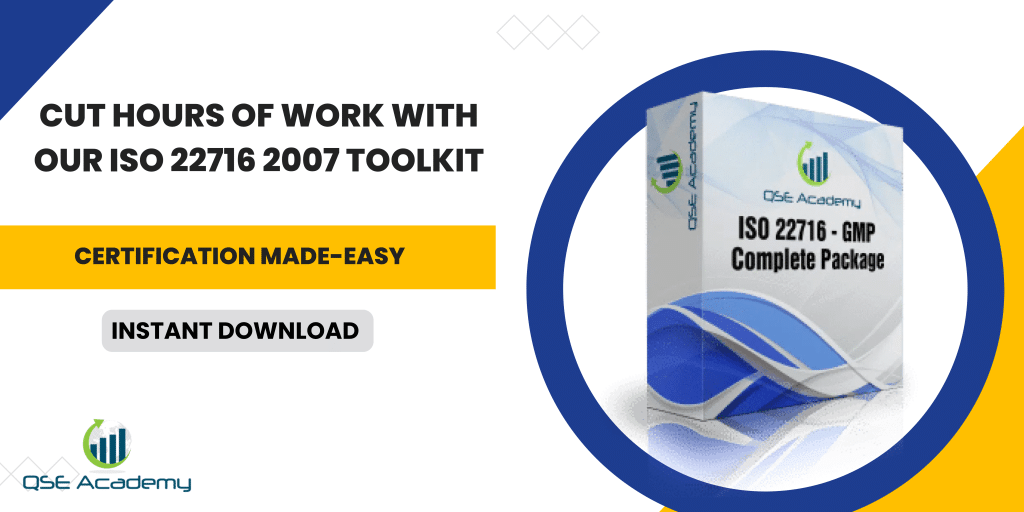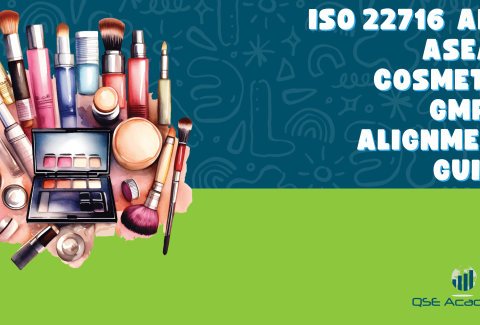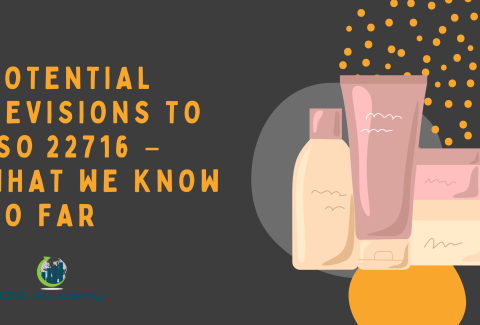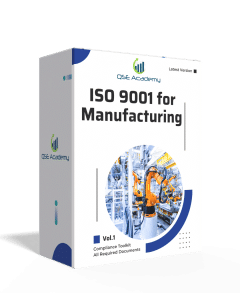ISO 22716 Complaints, Recalls & Change Control
Last Updated on October 24, 2025 by Hafsa J.
Why Complaint, Recall & Change Control Systems Matter in ISO 22716
No cosmetic brand plans for things to go wrong—but sometimes they do. A batch reacts differently, a customer reports irritation, or a label error slips through. What separates a compliant manufacturer from a risky one isn’t the absence of problems—it’s how they’re managed.
In ISO 22716, complaint handling, recalls, and change control are your safety valves. They ensure that when something goes off track, your team acts fast, traces the issue, and fixes it without losing customer trust or regulatory footing.
I’ve seen small cosmetic businesses nearly lose their certification simply because complaints were “handled verbally” or a recall plan existed only on paper. ISO 22716 closes those gaps by requiring documented, traceable systems that link every issue, decision, and corrective action.
In this guide, you’ll learn:
-
How to handle complaints in a structured, transparent way.
-
How to plan and execute a recall before it becomes an emergency.
-
How to manage changes—big or small—without compromising GMP.
-
And how all three processes feed into continuous improvement.
When managed right, these systems don’t just protect your compliance—they protect your reputation.
Complaint Handling – Turning Issues into Improvement Opportunities
Every complaint tells a story. Sometimes it’s frustration from a customer; other times it’s an early sign that something in your process needs attention. Under ISO 22716, complaints aren’t just customer-service matters—they’re quality signals that deserve structured follow-up.
A compliant complaint-handling process includes four key steps:
-
Receipt and Documentation – Record every complaint, no matter how small. Include product name, batch number, customer details, and a clear description of the issue.
-
Evaluation and Categorization – Classify by severity (minor, major, or critical). A complaint about fragrance is different from one involving skin irritation.
-
Investigation – Review batch records, retain samples, and test if necessary. Involve QA early—don’t leave it to customer service alone.
-
Response and Closure – Communicate findings and corrective actions back to the complainant, and keep records updated for future trending.
Here’s what I’ve noticed in well-run cosmetic companies: they treat complaints as a goldmine of insight. Every issue logged and analyzed becomes a step toward better formulations, packaging, or customer trust.
Pro Tip:
Design a Complaint Evaluation Form that prompts your team to ask the right questions—Was the product stored properly? Is this issue recurring? Has this batch shown any deviation before? It saves time and gives investigations real structure.
Common Pitfall:
Handling complaints verbally or via email threads that never make it into your quality system. ISO 22716 expects a traceable log, not a memory bank.
Handled right, complaints become your most honest feedback loop. They’re not failures—they’re opportunities to prove your system works even under pressure.
Complaint Investigation & Root-Cause Analysis
Once a complaint is received, ISO 22716 expects you to go beyond acknowledgment—you need to investigate. Every complaint must lead to a documented, fact-based assessment that determines whether there’s a real quality issue, an isolated event, or a systemic problem.
Here’s how an effective investigation flows:
-
Gather all evidence. Review batch records, testing data, storage conditions, and any customer-supplied samples.
-
Check for patterns. Compare against previous complaints, deviation reports, or stability results.
-
Identify the root cause. Use structured tools like the 5 Whys or a Fishbone (Ishikawa) diagram to avoid guesswork.
-
Decide on corrective action. This might include retraining, process revision, or additional QC testing.
-
Document and verify. Close the loop only after confirming that the action eliminated the issue.
In my experience, the best investigations feel more like detective work than damage control. You’re not just asking “what happened?”—you’re asking “why did it happen, and how do we keep it from happening again?”
Pro Tip:
Form a small Complaint Review Team—usually QA, Production, and R&D. Different perspectives catch details that one department alone might overlook.
Common Pitfall:
Closing a complaint with “no defect found” simply because the product looks fine. Without documented testing or batch review, that statement won’t hold up during an audit.
Real Example:
One cosmetic company I advised discovered recurring texture complaints traced back to a subtle mixing-speed variation. Once the parameter was locked in and operators retrained, complaints dropped to zero within two months.
A strong investigation process turns complaints from reputational threats into lessons that strengthen your GMP foundation.
Product Recall Procedure – Planning for the Unexpected
No one enjoys talking about recalls, but pretending they’ll never happen is the fastest way to fail an audit. ISO 22716 requires every cosmetic manufacturer to have a documented, tested recall procedure—because quick, coordinated action protects both consumers and your brand’s reputation.
A good recall plan doesn’t start when the problem hits. It’s built in advance, with clear roles, responsibilities, and communication lines. Here’s what it should include:
-
Recall triggers:
Complaints, lab results, supplier notifications, or regulatory alerts. Anything suggesting a potential safety or quality issue should trigger evaluation. -
Recall decision-making:
QA and management must assess the risk and decide whether to initiate a recall or a product withdrawal. Every decision must be documented. -
Recall execution:
-
Identify all affected batches through batch and distribution records.
-
Notify distributors, retailers, and, if necessary, regulatory authorities.
-
Recover products quickly and safely.
-
-
Communication:
Define templates for customer notifications, internal memos, and authority reports. Consistency here prevents panic and confusion. -
Verification:
Confirm how much product was recovered, how much remains in circulation, and document the results in a recall report.
Pro Tip:
Run a mock recall at least once a year. Pick a random batch and see how long it takes to trace it from customer back to raw material. If it takes more than a few hours, your traceability system needs tightening.
Common Pitfall:
Relying on one person to manage everything. A recall should be team-driven—QA leads it, but logistics, customer service, and management all play key roles.
Real Example:
I once supported a recall where every product was traced and recovered within 24 hours because the company had practiced regularly. Their audit report later praised it as “a textbook example of GMP control in action.”
Planning ahead turns a recall from chaos into control—and shows auditors that your quality system doesn’t crumble under pressure.
Recall Documentation, Reporting & Follow-Up
A recall doesn’t end when products are returned—it ends when every detail is documented, verified, and closed out. ISO 22716 places strong emphasis on traceability and follow-through, because documentation is the only proof that your recall was controlled and effective.
Here’s what a complete recall record should include:
-
Reason for recall: a brief, factual summary of what triggered it.
-
Scope: product name, batch numbers, quantities involved, and affected markets.
-
Timeline: key dates for initiation, notifications, and completion.
-
Actions taken: who was informed, how recovery was managed, and how materials were disposed of or reprocessed.
-
Effectiveness check: reconciliation between distributed and recovered quantities.
-
Corrective actions: what was done to prevent recurrence.
In my experience, this last part—effectiveness checks—is where most companies struggle. It’s not enough to say, “We recalled the batch.” Auditors want proof that every affected product was traced and accounted for.
Pro Tip:
Include a “recovered vs. distributed” table in your recall report. It’s quick for auditors to review and clearly shows your level of control.
Common Pitfall:
Closing a recall too early, before verifying whether all downstream customers have responded. Always follow up until you have confirmation—or documented proof of attempts—from every point of distribution.
Real Example:
A cosmetic brand I advised once used a simple shared tracker to log recall responses from distributors. They achieved 98 % recovery in three days and impressed regulators with their precision.
Thorough documentation doesn’t just meet ISO 22716—it demonstrates maturity. It tells regulators and auditors that your system can handle a crisis with composure, accuracy, and accountability.
Change Control – Managing Modifications Without Losing Compliance
Change is inevitable in cosmetics—new ingredients, updated packaging, better equipment, revised suppliers. But under ISO 22716, every change, no matter how small, must be evaluated, approved, and documented before it happens. That’s what keeps progress from turning into risk.
Change control is your formal way of asking, “What could this change affect?” before you act. It ensures that modifications don’t unintentionally disrupt quality, safety, or compliance.
Here’s how a solid change-control process works:
-
Initiation: The person proposing the change fills out a Change Request Form detailing what’s changing and why.
-
Impact Assessment: QA, Production, and other relevant teams evaluate how the change might affect product quality, equipment, methods, labeling, or documentation.
-
Approval: Management and QA sign off only when risks are addressed and required tests or validations are planned.
-
Implementation: The change is made under controlled conditions with documented verification steps.
-
Post-implementation review: Check if the change performed as intended and didn’t create unintended consequences.
Pro Tip:
Use a Change Control Register to track every modification—from ingredient updates to packaging design. Include approval dates, responsible persons, and verification results. Auditors love seeing this—it shows you manage your system proactively.
Common Pitfall:
Making informal updates like “just switching fragrance suppliers” or “relabeling a bottle” without documenting the evaluation. These small changes can alter product performance or stability—and without records, you lose traceability.
Real Example:
One manufacturer I worked with introduced a new emulsifier without QA approval, assuming it was “chemically similar.” Within weeks, customers reported separation issues. After implementing proper change control, they caught similar risks early—and avoided repeat incidents.
When you treat change as a controlled process instead of a quick decision, you protect your compliance, your consistency, and your credibility.
CAPA Integration – From Complaint to Continuous Improvement
A strong GMP system doesn’t stop at fixing problems—it learns from them. ISO 22716 expects you to connect complaints, recalls, and change control through a structured Corrective and Preventive Action (CAPA) process. This is how good manufacturers become great ones—by making improvement a habit, not a reaction.
Here’s how CAPA ties it all together:
-
Complaints reveal product issues.
-
Recalls expose gaps in traceability or decision-making.
-
Change control helps you prevent those same issues in the future.
CAPA sits in the middle, linking them all into one continuous improvement loop.
A practical CAPA system includes:
-
Identification: Capture the issue—complaint, deviation, or audit finding.
-
Investigation: Determine the root cause, not just the symptom.
-
Action Plan: Define what needs to be corrected now and what should be prevented later.
-
Verification: Check if the action worked and update documentation.
-
Trending: Analyze recurring issues quarterly to identify weak spots in your process.
Pro Tip:
Use a CAPA Tracker with clear status updates (Open, In Progress, Closed). During audits, it shows transparency and control.
Common Pitfall:
Treating CAPA as paperwork instead of learning. If you close an issue without verifying effectiveness, you’re only pausing the problem—it’ll resurface later.
Real Example:
A cosmetics company I supported began trending complaint categories every quarter. They discovered 60% of their issues were packaging-related, not formulation. Fixing one packaging supplier reduced overall complaints by half—proof that CAPA drives real improvement when data is used smartly.
CAPA isn’t just a form—it’s your feedback system. It turns every challenge into progress and shows auditors that your organization doesn’t just comply—it evolves.
FAQs – ISO 22716 Complaints, Recalls & Change Control
Q1: What triggers a product recall under ISO 22716?
Any confirmed or suspected quality, labeling, or safety issue that could impact consumers. It might come from customer complaints, lab testing, or supplier notifications. Even a potential issue must be investigated immediately—ISO 22716 values caution over assumption.
Q2: How long should complaint and recall records be kept?
Keep all related records for at least the product’s shelf life plus one year, or longer if your local regulations require it. That includes complaint forms, investigation notes, recall reports, and CAPA records. Auditors often trace back years of data to evaluate your consistency.
Q3: What’s the difference between change control and corrective action?
Change control is planned—you’re introducing a modification intentionally, like updating packaging or equipment.
Corrective action is reactive—you’re fixing a problem discovered through a complaint, deviation, or audit.
Both require documented evaluation, QA approval, and follow-up to verify effectiveness.
Q4: How often should we test our recall procedure?
At least once a year. ISO 22716 recommends mock recalls to confirm that your traceability and communication systems work in real conditions. The goal is to find weaknesses before a real emergency ever happens.
Q5: Who should be involved in the complaint and recall process?
Ideally, it’s a team effort. Quality Assurance leads, but Production, Logistics, Customer Service, and Management must all play roles. Complaints, recalls, and change control only work when everyone understands their responsibility.
Key Takeaways and Next Steps
Every cosmetic manufacturer hopes never to face a serious complaint or recall—but ISO 22716 reminds us that preparedness is part of professionalism. These processes aren’t about expecting failure; they’re about proving you can respond fast, trace accurately, and learn continuously.
Here’s what to remember:
-
Document every complaint—even the minor ones—because they often reveal early warning signs.
-
Plan your recall system now, not when you need it. Practice with mock recalls to keep your team sharp.
-
Control every change—no shortcuts, no assumptions. Every modification deserves a risk check.
-
Connect everything through CAPA. Let data guide your improvements, not guesswork.
In my experience, the companies that handle issues best are the ones that never hide them. They treat each incident as a test of system strength, not a failure. When complaints, recalls, and change control flow together, your entire quality system becomes stronger, smarter, and far more respected by auditors.
If you’re ready to build that kind of resilience, QSE Academy’s ISO 22716 Quality System Toolkit can help. It includes editable templates for complaint logs, recall reports, change-control forms, and CAPA trackers—all designed to keep your system audit-ready and your team aligned.
Protect your brand before problems arise — explore QSE Academy’s toolkit and turn control into confidence.
Whether it’s ISO 9001, ISO 22000, or the cosmetics-focused ISO 22716, I’ve spent my career I’m not here to call myself an expert—I prefer “enthusiast” because I truly love what I do. When I’m not writing about standards, you’ll probably find me playing Piano 🎹, connecting with people, or diving into my next big project💫. I’m an engineer specialized in the food and agricultural industry
make ISO standards less intimidating and more approachable for everyone.
turning complex jargon into clear, actionable steps that businesses can actually use.
There’s something incredibly rewarding about helping people navigate food safety and quality management systems
in a way that feels simple, practical, and even enjoyable.
I have a Master’s in QHSE management and over 12 years of experience as a Quality Manager
I’ve helped more than 15 companies implement ISO 9001, ISO 22000, ISO 22716, GMP, and other standards
My clients include food producers, cosmetics manufacturers, laboratories, and service companies
I believe quality systems should be simple, useful, and efficient.

